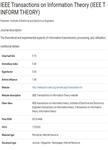版权所有:内蒙古大学图书馆 技术提供:维普资讯• 智图
内蒙古自治区呼和浩特市赛罕区大学西街235号 邮编: 010021

作者机构:Univ Calif Irvine Ctr Pervas Commun & Comp CPCC Irvine CA 92697 USA
出 版 物:《IEEE TRANSACTIONS ON INFORMATION THEORY》 (IEEE Trans. Inf. Theory)
年 卷 期:2025年第71卷第4期
页 面:2604-2625页
核心收录:
学科分类:0808[工学-电气工程] 08[工学] 0701[理学-数学] 0812[工学-计算机科学与技术(可授工学、理学学位)]
基 金:NSF [CCF-2221379] Office of Naval Research (ONR) [N000142412618]
主 题:Transmitters Receiving antennas Coherence Wireless networks Transmitting antennas Interference channels Full-duplex system Signal to noise ratio Training Symbols Reconfigurable devices Broadcasting MISO Distributed computing
摘 要:In order to explore how blind interference alignment (BIA) schemes may take advantage of side-information in computation tasks, we study the degrees of freedom (DoF) of a K user wireless network setting that arises in full-duplex wireless MapReduce applications. In this setting the receivers are assumed to have reconfigurable antennas and channel knowledge, while the transmitters have neither, i.e., the transmitters lack channel knowledge and are only equipped with conventional antennas. The central ingredient of the problem formulation is the message structure arising out of the Shuffle phase of MapReduce, whereby each transmitter has a subset of messages that need to be delivered to various receivers, and each receiver has a subset of messages available to it in advance as side-information. We approach this problem by decomposing it into distinctive stages that help identify key ingredients of the overall solution. The novel elements that emerge from the first stage, called broadcast with groupcast messages, include an outer maximum distance separable (MDS) code structure at the transmitter, and an algorithm for iteratively determining groupcast-optimal reconfigurable antenna switching patterns at the receiver to achieve intra-message (among the symbols of the same message) alignment. The next stage, called unicast with side-information, reveals optimal inter-message (among symbols of different messages) alignment patterns to exploit side-information, and by a relabeling of messages, connects to the desired MapReduce setting.